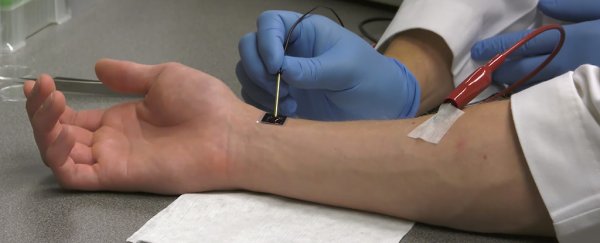Imagine buzzing the skin over an internal wound with an electrical device and having it heal over just a few days – that's the promise of new nanochip technology that can reprogram cells to replace tissue or even whole organs.
It's called Tissue Nanotransfection (TNT), and while it's only been tested on mice and pigs so far, the early signs are encouraging for this new body repair tool - and it sounds like a device straight out of science-fiction.
The prototype device, developed by a team at Ohio State University, sits on the skin and uses an intense electrical field to deliver specific genes to the tissue underneath it. Those genes create new types of cells that can be used nearby or elsewhere in the body.
"By using our novel nanochip technology, injured or compromised organs can be replaced," says one of the study leaders, Chandan Sen. "We have shown that skin is a fertile land where we can grow the elements of any organ that is declining."
During animal tests, researchers were able to use TNT to reprogram skin cells on the outside of injured legs to become vascular cells, which are key to regulating a healthy blood flow through the body.
Within a week, active blood vessels appeared in the injured legs, and by the second week the injured legs had been saved by TNT.
What's more, nerve cells generated in the lab using the same technique were used to successfully help brain-injured mice recover from a stroke.
"This is difficult to imagine, but it is achievable, successfully working about 98 percent of the time," says Sen. "With this technology, we can convert skin cells into elements of any organ with just one touch."
Other scientists are already investigating ways of reprogramming cells to repair the body, but what makes this particular technique stand out is that it skips the usual intermediary step of creating pluripotent stem cells, cells that can then turn into any other cell type.
In this case the cells go straight from skin cells to another variety of cell, all thanks to the targeted release of genes and an electrical pulse.
The TNT technology is made up of two components: the nanotechnology-based chip that sits on the skin, about the size of a cufflink, and the biological cargo it contains to affect the tissue underneath.
The chip gets zapped with a harmless electrical charge to release the cargo into the cell membranes, and the chip can then be removed.
According to the researchers it all takes less than a second to apply. The process is non-invasive, and because the reprogrammed cells are already in the patient's body, immune suppression is not required to make sure the new tissue is accepted.
We should note that there's still a long way to go before we could use this process on our own bodies, but the researchers are continuing to refine the technique and work towards human trials sometime next year.
"The concept is very simple," says one of the researchers, L. James Lee. "As a matter of fact, we were even surprised how it worked so well."
"In my lab, we have ongoing research trying to understand the mechanism and do even better. So, this is the beginning, more to come."
The research has been published in Nature Nanotechnology.
The team also put together a video explaining how the technique works, which you can see below:
